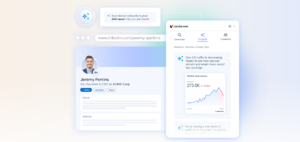By Jon Clarke, Founder & CPO, Cyance
As with most data, it’s quality, not quantity that’s crucial when it comes to intent. The right intent data, when it is relevant and accurate, has the potential to transform sales pipelines and create meaningful, lasting engagement with customers and prospects.
Over recent months, I’ve seen an influx of agencies and vendors claiming to offer intent data services, but providing very little clarity about what type of data they are delivering and where it’s coming from, and in particular no significant detail on how it can be applied by businesses.
The longer this goes on and the more often the term is used without any clear definition, the more confused sales and marketing professionals will become. And unfortunately that means the real value that intent data can and should be delivering for B2B businesses will be lost on some people.
With this in mind, I think there are three key elements that need to be clarified. Firstly, what intent actually is and the different types of intent available. Once those two pieces are understood then marketers need to understand that some intent data is more effective than others, most often dependent on the geography of your business, where you are based and what you are trying to achieve.
Before investing in intent data, it’s important for businesses to have clear, specific and measurable needs and objectives. This enables them to have a defined brief against which to evaluate the ever-growing number of available options.
Understanding Intent Data
Essentially, intent data works with predefined keywords and taxonomies that give a level of behavioural signals to indicate buyer intent. Intent data providers generally fall into one of three categories:
- Third party intent data vendors, such as Cyance – they will pick up on behaviour across a series of general websites that exist and are relevant to your business. They will collate all of this information, attribute that to companies and make it available in either a data feed or online platform.
- Second party vendors – these tend to be quite limited and ‘walled’ solutions that have their own set of websites and they only track behaviour across those specific sites. Quite often this is based upon known users that are filling in forms in order to download information or sometimes they are captured in a database and called manually by telemarketing teams.
- First party vendors – this is simply the process of capturing and analysing the data from visitors to your own website.
Why Accuracy is Key
The next step, nnce sales and marketing professionals have understood these different types of intent data and established what will generate the best results for their business, is to select the marketplace which will provide the greatest levels of accuracy.
The primary driver for using intent data is to help an organisation drive greater efficiency in achieving its sales goals. A more efficient business will achieve faster growth, scalability and greater productivity, all of which lead to more profits. Intent data has a significant role to play in propelling an organisation towards that end goal.
Prior to having intent data, B2B marketers had very little in terms of actionable insight on both their existing and potential customers. This inevitably led to an inefficient and sometimes scattergun approach to marketing and lead generation activities. Intent data really turned everything around, enabling organisations to pinpoint, with laser precision, those prospects that look like they’re on a relevant buying journey through their online behaviour and research.
However, intent data has now evolved beyond this point, with the overlaying of additional contextual information with behavioural data. For instance, marketers can now know when a particular prospect has been through an investment round and is therefore likely to be in a significant stage of growth. Or it may be that a company has made an acquisition and will need new technologies or consultancies to help with integrating the new business.
Being able to overlay a wide range of these types of signals or sales triggers massively increases the accuracy and relevance of intent data and gives sales and marketing teams complete confidence about which prospects they should be targeting and what type of message will resonate best.
Honing in on Accurate Intent
Intent is continually evolving, as you would expect with new technologies, we’re continuing to learn what works and what doesn’t. Innovations are emerging that can delve deeper into behavioural signals to form a much more informed picture of buyer interests and needs and start to accurately indicate what signals ‘real’ intent versus misleading behaviour. By mapping signals to a more defined and personalised description of intent, we can then start to accurately predict the ‘fit’ or readiness of buyer behaviour to a particular product or service.
There’s also more opportunity now, as we collate more signals, to introduce machine learning into the mix and let algorithms and AI do the heavy lifting. This allows for analysis of billions of signals on a daily basis and being able to track the outcomes. It’s still important to evidence both the negative and positive outcomes from this activity so as to ‘train’ an algorithm. Over time it will learn what works, what doesn’t, what points are more significant than others and when to present this information back for the most effective and positive results. We’ve found that companies that embrace both the best of a human and a technological workforce are producing the most conversions.
Finally, another important part of driving accuracy is having access to local intent data for each region or country. This is particularly pertinent for businesses looking to target buyers in Europe, many of which still rely solely on intent data generated on US websites, rather than European sites (and local language sites). This means these businesses are missing out on a huge number of high-value signals which could significantly improve the accuracy and quality of their intent data, leading to higher conversion rates and sales. Furthermore, vendors that are based in Europe and live GDPR are much more likely to understand the nuances of compliance, have DOs in place and the data is hosted in Europe, they understand that GDPR is a framework that is enabled differently between countries.
Accuracy Leads to Better Engagement
Ultimately, by prioritising accuracy within intent data, businesses can develop greater engagement with potential buyers and existing clients, throughout the buying journey and ongoing customer lifecycle.
Used well, accurate intent data can inform a more personalised experience leveraging tailored content and messaging that is designed specifically for the needs and objectives of a particular account
This gives sales and marketing teams the ability to define and focus on priority accounts based on their fit and propensity to convert, leaving behind the scattergun approach to digital marketing that still resides in places. The end result is better leaders and higher conversions – but that start point must always be accuracy.









